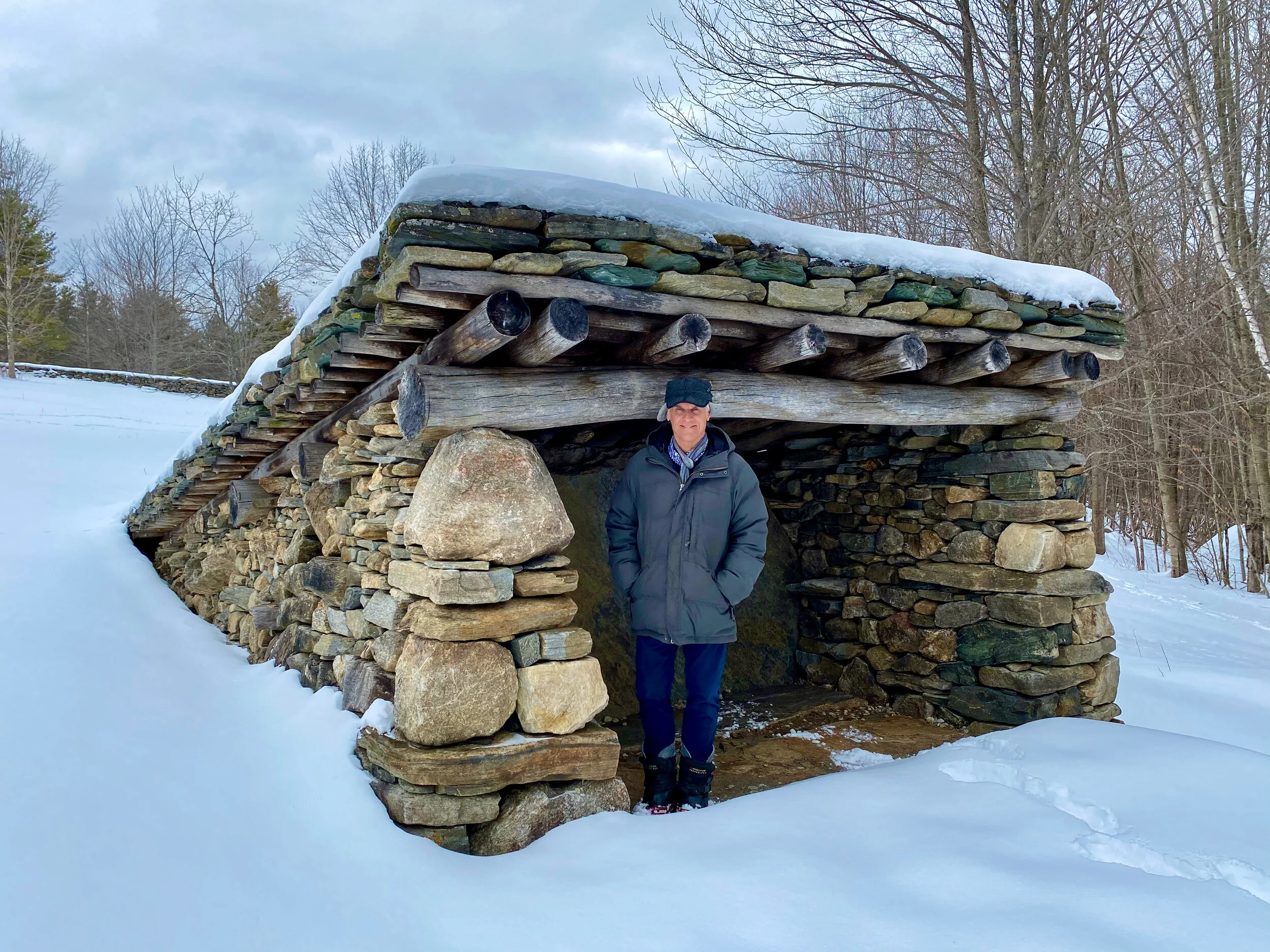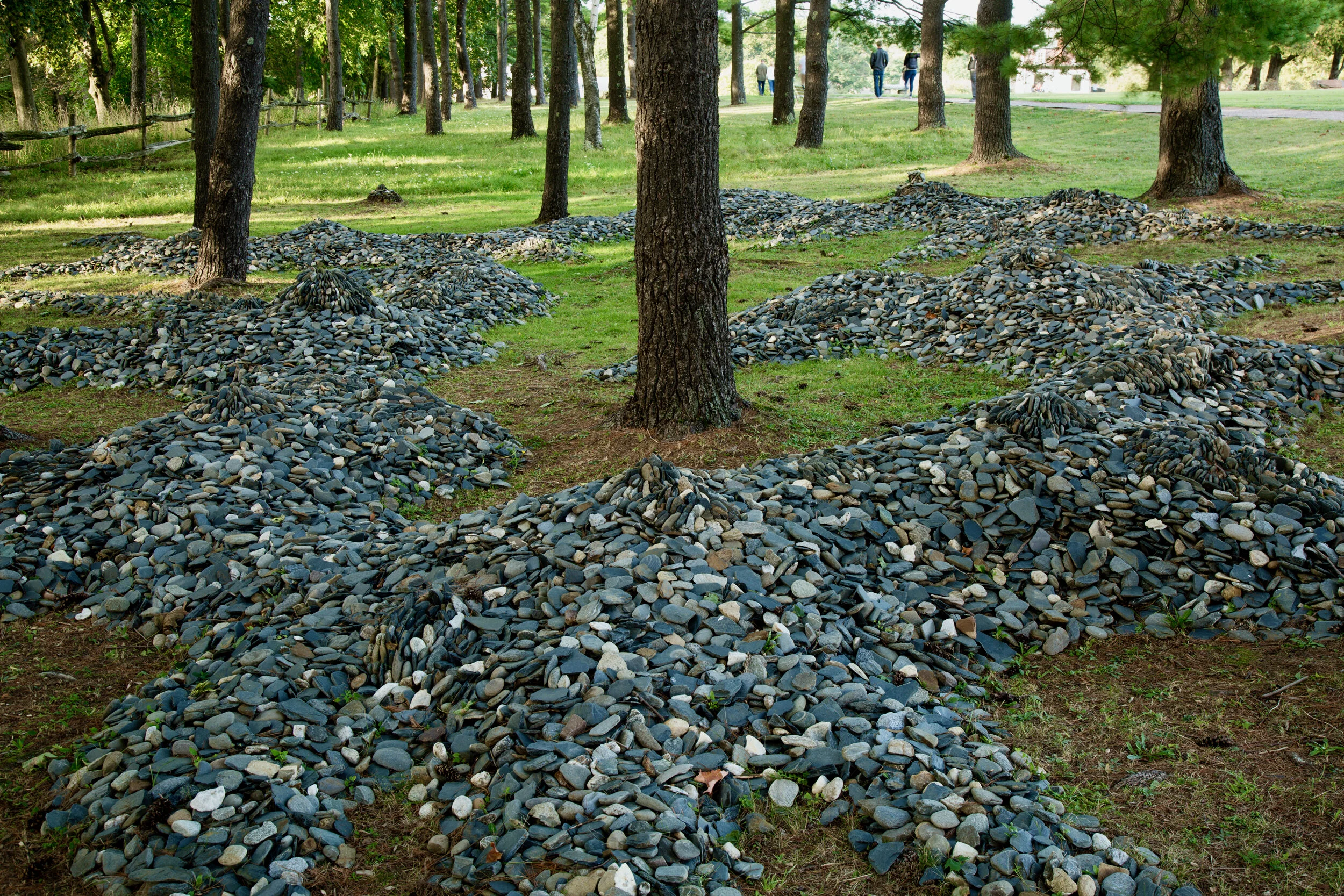If the rock scramble and stone sculpture I recently constructed for East End Park in Woodstock, Vermont looks a little like it could have been the result of coincidental events visited on the landscape, then I’ve succeeded in realizing my dream for it.
Read MoreThe Carving Studio and Sculpture Center in Rutland, Vermont is host to a sculpture park chock-full of outdoor delights. The dry stone wall built by participants from a workshop I instructed there in 2019 became the lead-in to a circular wall surround.
Read MoreRock Shelter is an environmental artwork that pays tribute to the materials it’s made from and the place it resides. The sculpture stands unpretentiously on the verge of a Vermont hayfield; a solitary figure with its back to the wind and face lifted to the low winter sun. The only perceivable change in the work since its creation is the mottled patina that’s grown over it.
Read MoreFantasy Topography rose up out of the forest floor last April. It became an object of intrigue for some of the visitors who wandered off the beaten path that circles the museum grounds. The pine tree glade has now returned to its former life as a quiet, shady glen. With all that passes, ours is the choice to hold in memory or let slip away.
Read MoreTo be in touch and in tune with nature has a centering effect on us. Couple the outdoors with a creative pursuit, and engagement with both is enriched because together they sharpen and heighten our spatial orientation. My environmental art piece Fantasy Topography seeks to bring pleasure to the core.
Read MoreThe studio has been filling up with rocky toppers this winter. The half-products are elements in a sculpture to be installed as part of a new outdoor exhibition at Shelburne Museum. The uniquely shaped objects will be arranged atop berms of loose stone. The completed piece will sprawl across the floor of a pine forest, flowing between and around the tree trunks.
Read MoreHaving landscaping and stonework done can be a geophysical boost to Earth’s well being in the long run but it’s not without short-term costs. Before the shovel goes in, here are some FAQs for a planet considering a surgical procedure.
Read MoreNavigating the process of a public art proposal feels like a long walk by flashlight through a snowstorm. Signs are unclear and paths become obscure along the way. Because the destination is not a geographically fixed point, there remain, at the conclusion of an artist’s unsuccessful bid to win a competition, questions about where they traveled, and why the trip dead-ended.
Read MoreUpon completion, the Bauble perched on its temporary base in the sugarhouse woodshed for three months while the adhesive that held it together cured.
Read MoreConditions being what they were of late with snow storm after snow storm, I stayed away from the stone project in-progress and gave myself a propertyless assignment. The premise was to compile a collection of photos that illustrate the work life of a solitary stoneworker; with myself as the subject and past projects as the source material.
Read MoreThe 2017 work year was a variety-pack of projects and travels bringing rocks and people together. Projects from 2017 now lie nestled in snow, while projects for 2018 are already underway.
Read MoreEnvironmental artworks in the public domain can quickly fall into the realm of personal legend. One of the best qualities of art in the outdoors is its ability to be endlessly personalized. Each new viewer makes it their own and every return visitor reestablishes their claim to it.
Read MoreA week on Sørvær in Northern Norway kept me immersed in the land and enveloped by the sea. The atmosphere of this island among islands is reigned by the sky above and waters below. Combined, they create an undeniably powerful influence. My moods changed at the whim of the weather. Even though I’ve spent my adult life working outdoors I’m unconditioned to the reality of light reflected from a vast and shifting water surface, or, tides streaming in and out all around. Grasping the totality of the archipelago's grand and sweeping vistas was a heady experience.
Read MoreWhat could be a more direct expression of form than molding earth in one’s hands? While the modes of earth shaping may vary, the impulse is ages old and remains strong as ever. My personal choice for satisfying the desire for hands-on interpretation of the earthly elements is the manipulation and configuration of loose stone. Within that narrow frame a wide variety of creative endeavors can be manifest.
Read MoreWhen they bought the old farmhouse in the early eighties the town road passed within eight feet of the front door. Robin and David Key were willing to overlook that serious drawback because they were in love with the ancient apple trees, the gurgling brook and the wealth of wildlife on the property. All of that was outside the back door just beyond a precipitous drop in the landscape. The retaining wall I would soon build to create a level backyard was the first in a series of dry stone projects we took on together over the following thirty years.
Read MoreEven without the silhouette of a crosswalking pedestrian or leaping deer, road signs with a triangular outline convey a message of caution; warning the traveler to be aware of what lies ahead. The sharp angles draw attention because they represent sudden change. Survival of the human species has depended on the ability of individuals to recognize signs of change and to adapt quickly to new situations.
Read MoreEnvironmental art serves a wider community. It can prosper plants and animals as well as humans. Art making in nature stirs the pot of local ingredients, recombining elements in ways previously untested. Wild things are opportunists; it’s programed into their DNA for survival. When something new appears in the landscape, ecologies respond. An environmental art work is breeding ground for creative adaptation. Its ultimate use is left up to the invention of its inhabitants.
Read MoreMy classmate, Hass, and I were standing on a rooftop on the lower west side of Manhattan watching a dance performance taking place in a vacant lot across the street when he nudged me and whispered, “That’s Robert Smithson.” The tall guy to my left at the parapet, in a cowboy hat and black trench coat, was solemnly staring down at the ground, along with a couple dozen other bohemes of the downtown art scene who had climbed four flights of rickety stairs in a derelict, cheese warehouse to view the show.
Read More
















